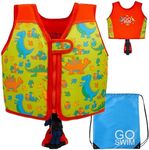Buying Guide for the Best Life Jacket For Kids
Choosing the right life jacket for kids is crucial for their safety during water activities. A well-fitted and appropriate life jacket can provide the necessary buoyancy and support to keep your child safe in the water. When selecting a life jacket, consider the child's weight, the type of water activity, and the environment in which it will be used. Here are some key specifications to look for and understand when picking a life jacket for kids.Size and FitSize and fit are essential for ensuring the life jacket works effectively. Life jackets are typically categorized by weight ranges. It's important to choose a life jacket that fits snugly but comfortably on your child. A jacket that is too loose can slip off, while one that is too tight can be uncomfortable and restrict movement. Measure your child's weight and chest size to find the right fit. Always try the life jacket on your child before purchasing to ensure it fits properly.
BuoyancyBuoyancy refers to the life jacket's ability to keep the wearer afloat. This is measured in pounds of force. For kids, life jackets usually have a buoyancy rating of 7 to 15 pounds. Higher buoyancy is generally better for younger children or those who are not strong swimmers. Consider the child's swimming ability and the type of water activity when choosing the buoyancy level. For example, higher buoyancy is recommended for open water activities.
Type of Life JacketThere are different types of life jackets, including Type II, Type III, and Type V. Type II life jackets are designed for calm inland waters and provide a higher level of buoyancy. Type III life jackets are more comfortable and suitable for general boating activities. Type V life jackets are specialized for specific activities like kayaking or water skiing. Choose the type based on the water activity your child will be participating in. For general use, Type III is often a good choice.
MaterialLife jackets are made from various materials, including nylon and neoprene. Nylon is lightweight and durable, making it suitable for most water activities. Neoprene is softer and more comfortable, often used for water sports. Consider the comfort and durability of the material when choosing a life jacket. If your child will be wearing the jacket for extended periods, neoprene might be a better choice for comfort.
Safety FeaturesLook for additional safety features such as crotch straps, reflective strips, and grab handles. Crotch straps help keep the life jacket securely in place, especially for younger children. Reflective strips enhance visibility in low light conditions, and grab handles make it easier to pull your child out of the water if needed. These features can provide extra security and peace of mind.
CertificationEnsure the life jacket is certified by relevant authorities such as the U.S. Coast Guard or other recognized organizations. Certification indicates that the life jacket meets safety standards and has been tested for effectiveness. Always check for certification labels when purchasing a life jacket to ensure it provides reliable protection.














